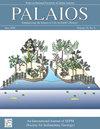意大利的森林化石揭示了二叠纪早期的近特提斯泛大陆湿地针叶树的繁盛
IF 1.5
4区 地球科学
Q2 GEOLOGY
引用次数: 0
摘要
原位化石林是研究古群落结构、环境及其生物生态的宝贵生物档案。在这里,我们展示了意大利北部昆古里安(下二叠世)亚齐斯火山群中第一批保存在其嵌入地层中生长位置的树木,这是后瓦里斯坎时期欧洲大陆最广泛的火山序列之一。基于高分辨率的相结构和岩石学记录,以及化石含量的古生物学和地学特征,我们重建了森林的结构、兴衰和古生态。一般来说,化石地层记录了一个由火山构造控制的湖沼,可能是低起伏火山景观的内河湿地盆地的基准面上升。这片森林以钙化的茎基和根的形式保存下来,生长在一个小的三角洲片洪扇上的湖面停滞期。森林由不到5米高的树木组成,它们的板状根系适应了浸水的基质,在快速淹没后被大量水流掩埋和破坏。这些质量流沉积物产生了次生木本碎屑,提供了针叶树作为化石林主要乔木植物的解剖学证据。我们的研究结果不仅阐明了古生代针叶树的根构型,而且记录了这些植物的生态形态可塑性,并证实了针叶树类在石炭/二叠纪边界附近的湿地中存在。此外,在研究的演替中,湖泊多年性的证据是欧洲二叠纪已知的最年轻的证据之一,指出了高度分化的晚期冰库对欧美热带大陆环境的影响。本文章由计算机程序翻译,如有差异,请以英文原文为准。
A FOSSIL FOREST FROM ITALY REVEALS THAT WETLAND CONIFERS THRIVED IN EARLY PERMIAN PERI-TETHYAN PANGEA
Abstract In-situ fossil forests are valuable biogenic archives for the structure and setting of paleocommunities and the ecology of their organisms. Here, we present the first trees preserved in growth position in their embedding strata from the Kungurian (lower Permian) Athesian Volcanic Group, Northern Italy—one of the most extensive volcanic successions of post-Variscan Euramerica. We reconstruct the structure, rise and demise, and paleoecology of the forest based on high-resolution documentation of facies architectures and petrography, and the paleontological and taphonomic characters of the fossil content. Generally, the fossiliferous strata record a volcanotectonically controlled base-level rise in a limnic, possibly endorheic wetland basin from a low-relief volcanic landscape. The forest, preserved as calcified stem bases with roots, grew during a short interval of lake-level stasis on a small deltaic sheetflood fan. The forest comprised trees less than 5 m tall with tabular root systems adapted to the waterlogged substrate, and was buried and destroyed by mass flows following rapid submergence. These mass-flow deposits yield parautochthonous woody debris providing anatomical evidence of conifers as the major arborescent plants of the fossil forest. Our results not only elucidate the root architecture of Paleozoic conifers, but also document the ecomorphological plasticity of these plants and substantiate the presence of coniferopsids in wetlands around the Carboniferous/Permian boundary. Further, the evidence of lake perenniality in the studied succession is among the youngest known from the Permian of Europe, pointing to the highly differentiated late-icehouse impacts on continental environments in the Euramerican tropics.
求助全文
通过发布文献求助,成功后即可免费获取论文全文。
去求助
来源期刊

Palaios
地学-地质学
CiteScore
2.80
自引率
12.50%
发文量
40
审稿时长
6 months
期刊介绍:
PALAIOS is a monthly journal, founded in 1986, dedicated to emphasizing the impact of life on Earth''s history as recorded in the paleontological and sedimentological records. PALAIOS disseminates information to an international spectrum of geologists and biologists interested in a broad range of topics, including, but not limited to, biogeochemistry, ichnology, paleoclimatology, paleoecology, paleoceanography, sedimentology, stratigraphy, geomicrobiology, paleobiogeochemistry, and astrobiology.
PALAIOS publishes original papers that emphasize using paleontology to answer important geological and biological questions that further our understanding of Earth history. Accordingly, manuscripts whose subject matter and conclusions have broader geologic implications are much more likely to be selected for publication. Given that the purpose of PALAIOS is to generate enthusiasm for paleontology among a broad spectrum of readers, the editors request the following: titles that generate immediate interest; abstracts that emphasize important conclusions; illustrations of professional caliber used in place of words; and lively, yet scholarly, text.
 求助内容:
求助内容: 应助结果提醒方式:
应助结果提醒方式:


